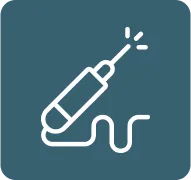A tongue tie (ankyloglossia) develops when the lingual frenulum – a ligament under the tongue – is restricted and movement becomes limited. Similarly, a lip tie is identified when the labial frenulum – the ligament attaching the upper lip to the gums – is tight. Both can hinder feeding, speech, oral hygiene, and affect growth and development over time.
An untreated tongue or lip tie can cause frustrating challenges in the short term and create long term consequences over time. Difficulty breastfeeding in infants, speech difficulties in young children, and eating challenges are common symptoms of restricted oral tissues.
As a child grows, the restriction can hinder proper airway development, leading to mouth breathing and sleep issues. Over time, an underdeveloped airway combined with compromised orofacial muscle function can inhibit jaw development and facial growth.


For Infants:

For Children:
Comprehensive Health Evaluation: This initial step involves a thorough examination of your child’s health. We focus on oral development, areas of restricted tissue, and functional challenges.
Myofunctional Assessment: A more targeted evaluation to gauge tongue mobility, strength, and function. This assessment helps us create a treatment plan specific to your child’s unique needs.
Parental Consultation: Sharing our findings, understanding your concerns, and aligning with you on health goals for your child. This conversation is where we give you the information you need to make decisions that feel right for you, your child and your family.
Pre-Procedure Guidance: To ensure you and your child are fully prepared for the procedure, we’ll provide you with detailed preparation instructions for the procedure, including a review of any recommended pre-treatment exercises or routines from the myofunctional therapist.
Collaboration with Specialists: This collaboration is tailored to your child’s unique conditions and needs. For instance, a child struggling with breastfeeding due to a tongue tie might benefit from the expertise of a lactation consultant. Our network can include pediatricians for comprehensive health reviews or speech therapists for children exhibiting speech delays.
Emotional Support: We’re here for support and reassurance. We understand what you’re going through and we want you to feel supported every step of the way.
Customized Care Plan: Your child will have a personalized treatment plan that addresses their distinct needs.

The goal of the procedure is to enhance your child’s oral functions—feeding, speaking, breathing, and sleeping—by releasing restricted oral tissue.


Before the procedure, the goals of myofunctional therapy are to:
Following the procedure, myofunctional therapy is used to:
Our myofunctional therapy program is a collaborative effort, involving:
Phone: (406) 587-KIDS (5437)
Monday
8 AM – 5 PM
Tuesday
8 AM – 5 PM
Wednesday
8 AM – 5 PM
Thursday
8 AM – 5 PM
Friday
8 AM – 2 PM
Saturday
Closed
Sunday
Closed
Copyright@2024 Bridger Children’s Dentistry All Rights Reserved. Website Design and Digital Marketing by Mad Rose Media.